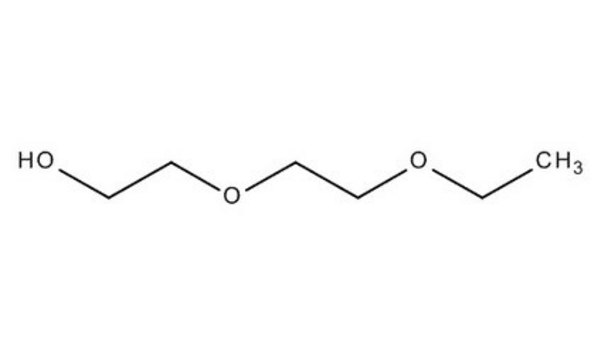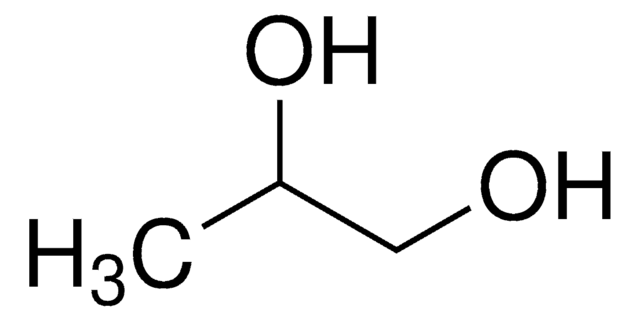8.03129
Diethylene glycol monobutyl ether
for synthesis
Synonym(s):
Diethylene glycol monobutyl ether, Butyl carbitol, 2-(2-Butoxyethoxy)ethanol, Butyl diglycol
About This Item
Recommended Products
vapor pressure
<1 hPa ( 20 °C)
Quality Level
Assay
≥98% (GC)
form
liquid
autoignition temp.
210 °C
potency
5660 mg/kg LD50, oral (Rat)
4120 mg/kg LD50, skin (Rabbit)
expl. lim.
0.7-5.9 % (v/v)
pH
7 (20 °C)
kinematic viscosity
6.1 cSt(20 °C)
bp
226-234 °C/1013 hPa
mp
-68 °C
transition temp
flash point 105 °C
density
0.95 g/cm3 at 20 °C
storage temp.
2-30°C
SMILES string
O(CCOCCCC)CCO
InChI
1S/C8H18O3/c1-2-3-5-10-7-8-11-6-4-9/h9H,2-8H2,1H3
InChI key
OAYXUHPQHDHDDZ-UHFFFAOYSA-N
Related Categories
Application
- Biopolymeric Anticorrosion Coatings from Cellulose Nanofibrils and Colloidal Lignin Particles.: This study describes the development of a novel anticorrosion coating made from biopolymers, including a discussion on the use of diethylene glycol monobutyl ether as a solvent to disperse components uniformly (Dastpak et al., 2021).
- The investigation of structural and thermosensitive properties of new phosphazene derivatives bearing glycol and amino acid.: This research article explores the properties of phosphazene derivatives that incorporate glycol structures, detailing methods like NMR and IR spectroscopy where diethylene glycol monobutyl ether may be employed as a solvent in the synthesis process (Uslu and Güvenaltın, 2010).
- Diethylene glycol mono butyl ether concentrations in room air from application of cleaner formulations to hard surfaces.: This study measures the air concentrations of diethylene glycol monobutyl ether in indoor environments following its application in cleaning agents, demonstrating its volatility and potential inhalation exposure during use (Gibson et al., 1991).
Analysis Note
Density (d 20 °C/ 4 °C): 0.951 - 0.954
Water (K. F.): ≤ 0.20 %
Peroxide (as H₂O₂): ≤ 0.05 %
Identity (IR): passes test
Signal Word
Warning
Hazard Statements
Precautionary Statements
Hazard Classifications
Eye Irrit. 2
Storage Class Code
10 - Combustible liquids
WGK
WGK 1
Flash Point(F)
210.2 °F - closed cup
Flash Point(C)
99 °C - closed cup
Certificates of Analysis (COA)
Search for Certificates of Analysis (COA) by entering the products Lot/Batch Number. Lot and Batch Numbers can be found on a product’s label following the words ‘Lot’ or ‘Batch’.
Already Own This Product?
Find documentation for the products that you have recently purchased in the Document Library.
Our team of scientists has experience in all areas of research including Life Science, Material Science, Chemical Synthesis, Chromatography, Analytical and many others.
Contact Technical Service







